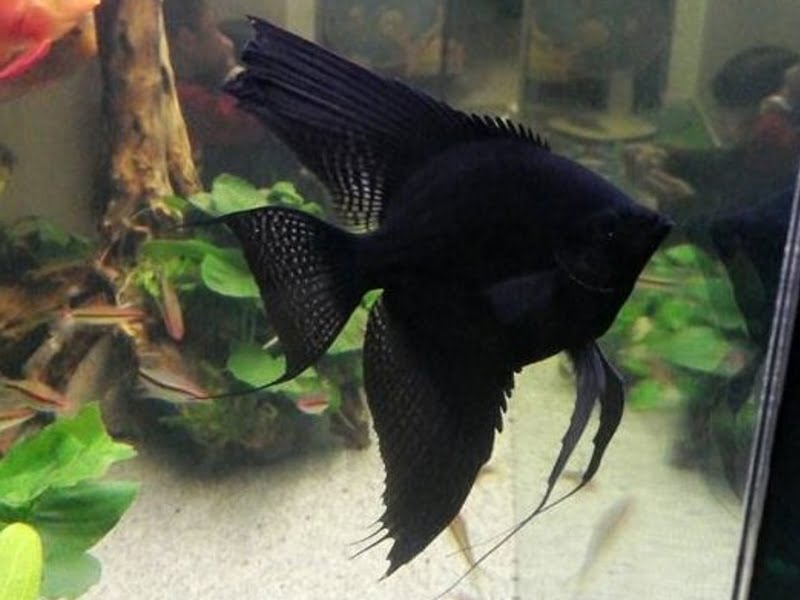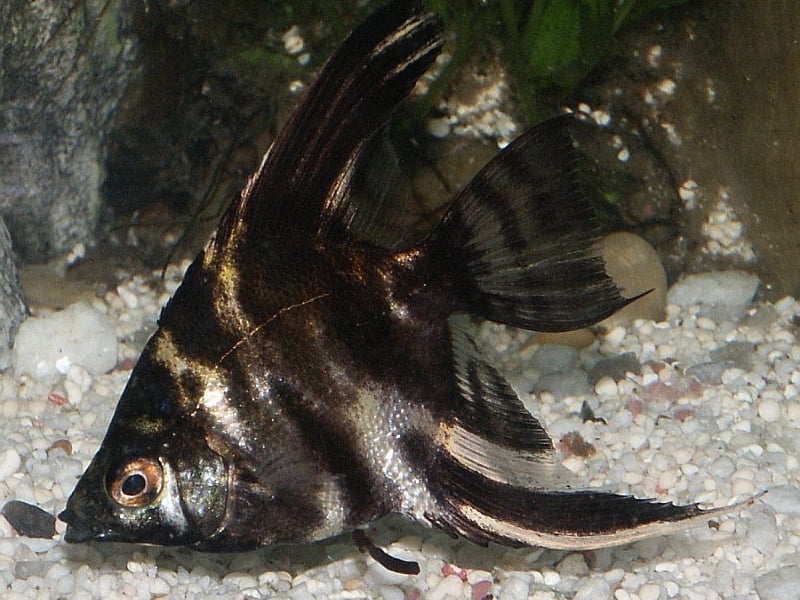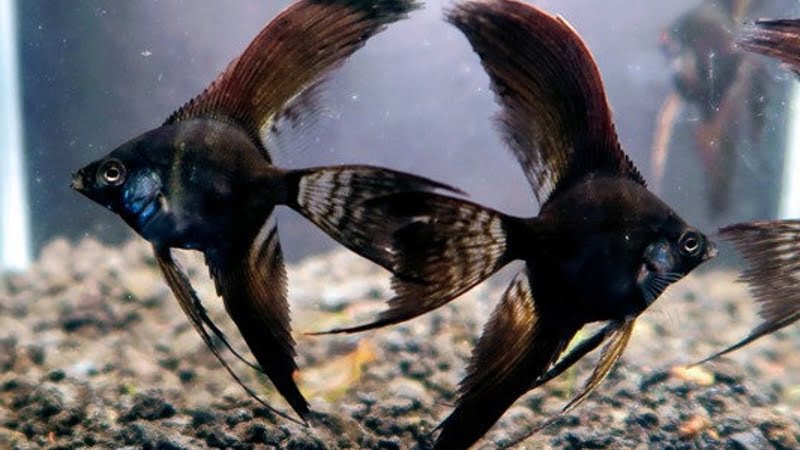Black angelfish are like angelfish, all their characteristics and daily activities are the same. But one thing that makes it different is that the species’ colour is black.
The scientific name of this fish is “Pterophyllum”, known as a genus of freshwater fish from the family Cichlidae in the genus Phyllophyllum is sometimes referred to as angelfish by aquarists.
Almost all Pterrophyllum species are native to the Amazonian Basin, the Orinoco Basin, and various rivers in the Guiana Shield of tropical South America.
Related Articles
- Coral Beauty Angelfish Best Profile: Habitat, Size, Behavior, Lifespan, Diet, Breeding & More
- Where To Buy Altum Angelfish? 3 Big Risks You Have To Face
- Altum Angelfish Care Guide: Lifespan, Size, Tank Size & Setup, Water Parameters, Breeding & More
- Koran Angelfish: All About Full Size, Reef Safe & More
A Brief History Of Black Angelfish
This is a species of freshwater angelfish, P. scalare. It was described by F. Schultze in the year 1824. The word “Perophyllum” comes from the Greek.
A description of P. Altum was published in 1906 by J.Pellegrin. The first known description of P. Leopoldi came from the scientist J. P. Gosse.
The Amazon Basin could still harbor unidentified species that are known to exist. Increasingly, new species of fish are being discovered and the differences between them, like those between P. Leopoldi and P. scalare, are sometimes subtle.
Detailed descriptions of the P. Leopoldi state that it is composed of 29 to 35 scales arranged in a lateral row, with a straight predorsal line, as opposed to the P. scalare, which is composed of 35 to 45 scales, arranged in a lateral row, with notched predorsal lines.
The coloration of P. Leopoldi is nearly identical to that of P. Scalare, except that a faint stripe is visible between the eye stripe and the first complete body stripe, and that an incomplete third stripe exists between the two main (complete) body stripes which extends three-quarters of the length of the body.
P. Scalare is the only scalar species that lacks the deep horizontal line that connects the eye stripe and first complete body stripe. And a third line that connects the two main body stripes rarely extends downward more than 50%, if ever-present.
During the early stages of development, P. Leopoldi fry has three to eight body stripes, although all of these stripes start to fade from one to five upon reaching adulthood, while P. Scalare has only two in true wild form throughout life.
In the 30 years since P. Leopoldi’s description, angelfishes have been bred in captivity for at least 30 years.
Aquatic Environment
Organisms
There is a common aquarium species called Pterophyllum Scalare which is common to many aquatic settings.
These plants are mostly captive-bred, and they are not available in the wild. Sometimes, it is possible to obtain a cultivation-grown Pterophyllum Altum.
Among the species of Peterophyllum, Leopoldi is the most challenging to find in the trade.

Care
In an aquarium for black angelfish, the water temperature should be kept around 80°F (27°C), ideally up to 90°F (32°C).
The angelfish family belongs to the cichlid family, but they are generally very peaceful unless they are hunting.
However, they have generally considered “big fish eat little fish” because they are very large and have a tendency to hunt.
The Raphael catfish can be a suitable tank mate since they have their own built-in armor to protect them.
Reproduction
P. Scalare is relatively easy to breed in a tank, yet one of the side effects of generations of inbreeding is that many breeds have lost their rearing instincts almost completely.
This results in the parents eating their young, which leads to the transfer of these diseases to the young.
Furthermore, it is very difficult for an individual to be classified accurately as male or female until it is near the time for reproduction.
A pair of angelfish from a living relationship over time. Each of the individuals will protect their partner against threats and possible rivals.
In cases where a mated pair has lost one of their members, either through death or removal, the remainder of the pair will not mate with any other angelfish and will refuse to successfully breed with subsequent partners.
As P. Scalare matures to sexual maturity over the course of six to twelve months, depending on the conditions of the aquarium, that duration could be longer.
Even when the eggs are taken from the aquarium immediately after their hatching, the pair are still capable of reproducing every seven to ten days as long as they are removed from the aquarium.
As the spawning frequency decreases around the age of three years, it eventually ceases altogether as the larvae mature.
After they have chosen an appropriate medium on which to lay their eggs, a pair of two-year-old fish pick off detritus and algae from the surface for one or two days, and after they have laid their eggs, the second pair of two-year-old fish does the same.
If you have a broad-leaf plant in the aquarium, then the medium can be placed vertically in the tank, a piece of slate, or even a length of pipe. I have also seen it done on the glass sides of the aquarium.
On the spawning substrate, after the female deposits a line of eggs, the male fertilizes the eggs by laying eggs of his own.
As a result of this process, you will eventually see a total of 100 to 1,200 eggs being laid, depending on the size and physical condition of the female fish.
In order for the offspring to develop properly, the pair takes turns swimming very close to the eggs and fanning them with their pectoral fins so as to maintain a high rate of water circulation around them throughout their development.
Eggs hatch within a few days, and the fry remains attached to the substrate for the duration of their lives. This is the period by which the fry are surviving by eating the remnants of the yolk sacs that were taken from them.
On the day of their one-week detachment, the fry begins to swim freely. After the eggs have detached for one week, successful parents make sure that the fry gets to swim freely.
It is recommended that the fry are fed appropriate-sized live food at the point when they are free-swimming.
This species can prove to be quite difficult to breed in a marine environment.

Life Expectancy
Several studies have confirmed that freshwater angelfish with good genetics are capable of surviving for more than 10 years (approximately 12 years) in captivity, as long as they are provided with the ideal living conditions.
According to researchers, if they are not threatened by their numerous natural predators, these owls might live up to 15 years in the wild.
Adaptability To Other Fish
There is a tendency for freshwater angelfish to be categorized in pet stores as semi-aggressive. Angelfish are compatible with a few types of tetras and barbs, but tetras and barbs that are too small can easily be eaten by angelfish.
In order to help your angelfish not attack their tank mates when they are hungry, you should make sure that you provide them with generous quantities of food.
Video About Black Angelfish
FAQs
How hard is it to keep black angelfish?
Keepers of angelfish do not have a hard time keeping them. They like to live in water with a reasonable range of parameters, most of which can be tolerated by these fish. In order to do this, you do not need a special aquarium to keep them.
Which angelfish is the prettiest?
The black-colored Black Lace Angelfish has flowing, lacy fins that give it a luxurious look.
Among all of the angelfish, many believe that it is the most attractive one. Among all of the angelfish, many believe that it is the most attractive one.
How big do black angelfish grow?
A typical adult measures about 6 inches long (15 cm) and 8 inches tall (20 cm). Sizes of typical purchases usually fall between 2 and 5 inches.

Annette M. Chaney is an experienced marine biologist with over 20 years of experience as an aquarist and fishkeeper. She started her first aquarium at a young age, filling it with frogs and goldfish obtained from the ten-cent pet store.
Annette grew up caring for and breeding African Cichlids, which led to a hobby in high school that doubled as a profitable means. Attending Reed College gave her time to solidify herself as an accomplished aquarium caretaker with an eye for sales. After that, from 2009 – 2013, she studied at Roger Williams University – one of the most prestigious universities for Aquaculture and Aquarium in USA. She is the founder of AquariumCircle since 2010.
